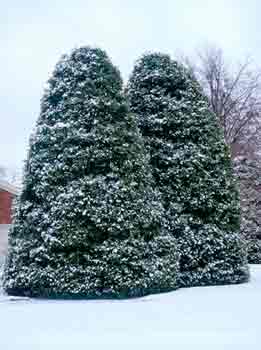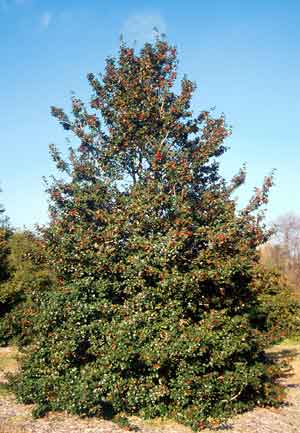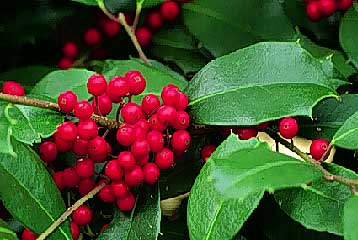 American Holly - Ilex opaca
American Holly - Ilex opaca
Holly Family (Aquifoliaceae)
Leaf miner and scale are the worst problems for American holly, but the tree has a long list of potential problems. These include bud moth, beetles, berry midge, whitefly, southern red mite, leaf spots, cankers, tar spot, bacterial blight, spot anthracnose, leaf rot, leaf drop, powdery mildew, twig die back, spine spot and leaf scorch.
- Native habitat: Massachusetts to Florida, west to Texas and Missouri.
- Growth habit: Densely pyramidal with branches to the ground when young; becomes open, irregular and high branching with age.
- Tree size: 40 to 50 feet tall with a spread ranging from 18 to 40 feet.
- Flower and fruit: Female flowers are solitary and dull white; male flowers are borne in three- to nine-flowered cymes. Male and female flowers are on separate trees. Fruit is a dull red, berry-like drupe borne on a 1/4-inch stalk. Fruit matures in October and persists into winter.
- Leaf: Alternate, simple, evergreen, 1½ to 3½ inches long, with large, spiny teeth. Leaves are dull to dark green on top, yellowish green below.
- Hardiness: Winter hardy to USDA Zone 5. Hardiness: Winter hardy to USDA zone 5.
There are more than 1,000 cultivars of American holly. The best cultivars are selected for bright fruit displays, attractive leaves and a dense habit. Because American holly is dioecious, male cultivars are also available. Bernheim Forest and Arboretum in Kentucky has one of the best collections of American holly. Representative cultivars include:
- ‘Goldie' - A yellow-fruited cultivar. It is an extra heavy fruiter. Other yellow-fruited cultivars include: ‘Canary,' ‘Longwood Gardens,' ‘Oakhill Yellow,' and ‘Morgan Gold.'
- ‘Grace McCutchin' - A cultivar selected for its orange-red fruit. Other cultivars with this unique color include: ‘Lake City' and ‘Manig.'
- ‘Jersey Knight' - A male cultivar with dark, shiny foliage. This is one of the Jersey hollies introduced by Dr. E. Orton from Rutgers University. It is an attractive tree even though it does not fruit. ‘Gable' is another male cultivar.
- ‘Jersey Princess' - An exceptional cultivar with excellent form, dark green glossy foliage and good fruit display. This is one of the Jersey hollies introduced by Dr. E. Orton from Rutgers University.
- Other heavy-fruiting cultivars with good form include: ‘Amy,' ‘Cheerful,' ‘Merry Christmas,' ‘ Miss Helen,' ‘Old Heavy Berry,' ‘Parkton,' ‘Torchbearer,' and ‘William Paca.' ‘Judy Evans' -
- Good all-around American holly for its conical shape, deep green leaves and red fruit display. Selected by Theodore Klein from a plant growing in Cave Hill Cemetery in Louisville, Ky.
 Additional information:
Additional information:One male American holly should be planted for every three females to ensure production of berries on female trees. The fruit is an excellent food source for wildlife. Raw berries are toxic to humans. Native Americans preserved holly berries for useas decorative buttons. These were highly prized trade items.
American holly wood has been used to make furniture, canes and scroll work. The wood has also been stained black and substituted for ebony in inlay work. Holly wood is ideal for taking dyes, and is used for much of the black and white inlaid lines in musical instruments and furniture. It is also used for knife handles and black piano keys.
American holly is the state tree of Delaware. A great deal of superstition once surrounded holly. It was believed that planting hollies near buildings would provide protection from witchcraft and lightning. It was also believed that the flowers of holly could be used to turn water to ice.



